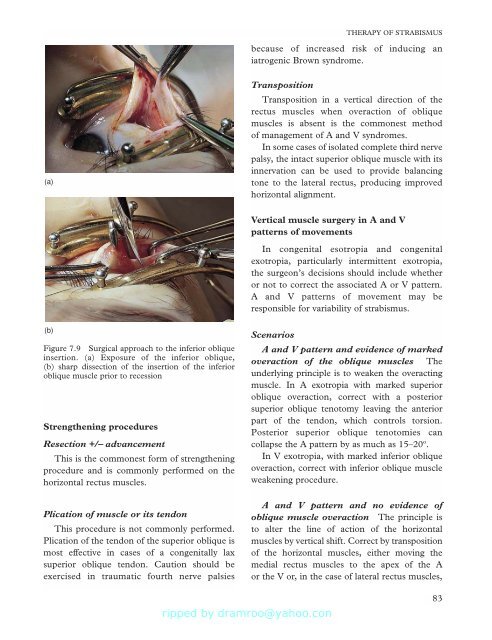Strabismus - Fundamentals of Clinical Ophthalmology.pdf
Strabismus - Fundamentals of Clinical Ophthalmology.pdf
Strabismus - Fundamentals of Clinical Ophthalmology.pdf
You also want an ePaper? Increase the reach of your titles
YUMPU automatically turns print PDFs into web optimized ePapers that Google loves.
THERAPY OF STRABISMUS<br />
because <strong>of</strong> increased risk <strong>of</strong> inducing an<br />
iatrogenic Brown syndrome.<br />
(a)<br />
Transposition<br />
Transposition in a vertical direction <strong>of</strong> the<br />
rectus muscles when overaction <strong>of</strong> oblique<br />
muscles is absent is the commonest method<br />
<strong>of</strong> management <strong>of</strong> A and V syndromes.<br />
In some cases <strong>of</strong> isolated complete third nerve<br />
palsy, the intact superior oblique muscle with its<br />
innervation can be used to provide balancing<br />
tone to the lateral rectus, producing improved<br />
horizontal alignment.<br />
Vertical muscle surgery in A and V<br />
patterns <strong>of</strong> movements<br />
In congenital esotropia and congenital<br />
exotropia, particularly intermittent exotropia,<br />
the surgeon’s decisions should include whether<br />
or not to correct the associated A or V pattern.<br />
A and V patterns <strong>of</strong> movement may be<br />
responsible for variability <strong>of</strong> strabismus.<br />
(b)<br />
Figure 7.9 Surgical approach to the inferior oblique<br />
insertion. (a) Exposure <strong>of</strong> the inferior oblique,<br />
(b) sharp dissection <strong>of</strong> the insertion <strong>of</strong> the inferior<br />
oblique muscle prior to recession<br />
Strengthening procedures<br />
Resection +/− advancement<br />
This is the commonest form <strong>of</strong> strengthening<br />
procedure and is commonly performed on the<br />
horizontal rectus muscles.<br />
Plication <strong>of</strong> muscle or its tendon<br />
This procedure is not commonly performed.<br />
Plication <strong>of</strong> the tendon <strong>of</strong> the superior oblique is<br />
most effective in cases <strong>of</strong> a congenitally lax<br />
superior oblique tendon. Caution should be<br />
exercised in traumatic fourth nerve palsies<br />
Scenarios<br />
A and V pattern and evidence <strong>of</strong> marked<br />
overaction <strong>of</strong> the oblique muscles The<br />
underlying principle is to weaken the overacting<br />
muscle. In A exotropia with marked superior<br />
oblique overaction, correct with a posterior<br />
superior oblique tenotomy leaving the anterior<br />
part <strong>of</strong> the tendon, which controls torsion.<br />
Posterior superior oblique tenotomies can<br />
collapse the A pattern by as much as 15–20º.<br />
In V exotropia, with marked inferior oblique<br />
overaction, correct with inferior oblique muscle<br />
weakening procedure.<br />
A and V pattern and no evidence <strong>of</strong><br />
oblique muscle overaction The principle is<br />
to alter the line <strong>of</strong> action <strong>of</strong> the horizontal<br />
muscles by vertical shift. Correct by transposition<br />
<strong>of</strong> the horizontal muscles, either moving the<br />
medial rectus muscles to the apex <strong>of</strong> the A<br />
or the V or, in the case <strong>of</strong> lateral rectus muscles,<br />
83










![SISTEM SENSORY [Compatibility Mode].pdf](https://img.yumpu.com/20667975/1/190x245/sistem-sensory-compatibility-modepdf.jpg?quality=85)





